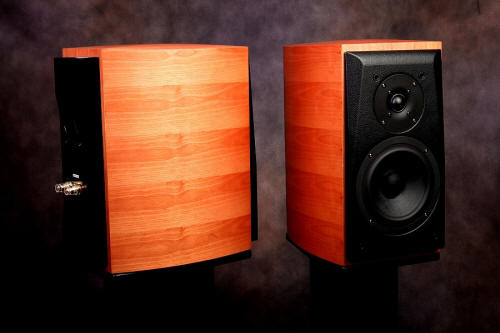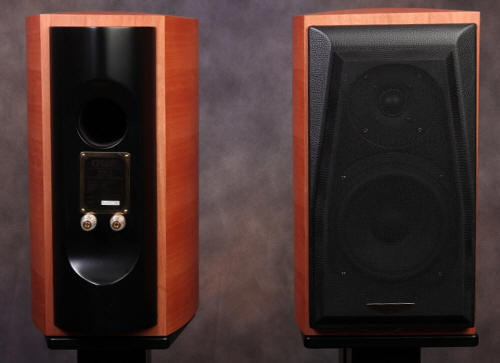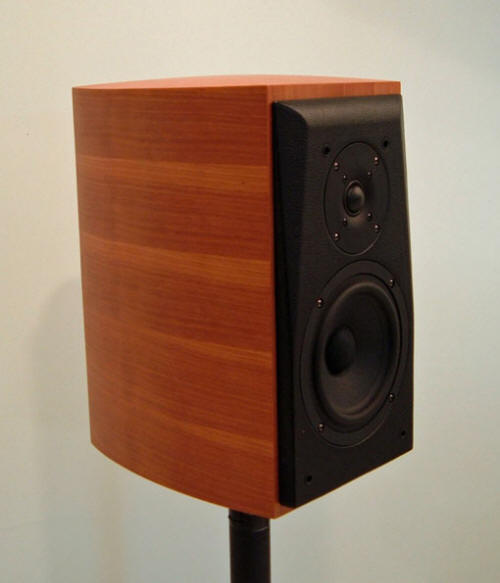You are reading the older HTML site
Positive Feedback ISSUE
46november/december 2009
grant fidelity
MBS-1 loudspeakers
as reviewed by Kent Johnson

|
KENT JOHNSON'S SYSTEM
LOUDSPEAKERS
ELECTRONICS
SOURCES
CABLES
ACCESSORIES SECOND SYSTEM
LOUDSPEAKERS
ELECTRONICS
SOURCE
CABLES
ACCESSORIES
|
I cannot imagine anyone not being impressed by the appearance of the Grant Fidelity MBS-1 speakers. They are truly gorgeous. The cherry veneer has as impeccable a level of fit and finish as I have seen and even extends to the bottom of the speakers. Under the veneer is a cabinet made of high-density MDF, which affords them a very reassuring solidity and weight.
The front baffle is covered in black leatherette that, along with the baffle's shape, helps to minimize diffraction effects. The sides of the speaker taper back to a rear panel that has the reflex port and a single pair of high quality binding posts.
The MBS-1s use a dome tweeter and a 6.5-inch cone mid/woofer. The drivers are custom OEM designs by Vifa and matched to less than 1% tolerances, according to Grant Fidelity. The crossover is first order, 6dB per octave, and audiophile parts are used, again, matched to 1% tolerances. Grant Fidelity claims that three years of development have gone into designing and building these speakers.
Grant Fidelity gives the HWD depth as 16 X 8.3 X 13 inches with a weight of 26 pounds per speaker. The efficiency is 88dB, with a nominal impedance of 8 Ohms. Frequency response is 45-22kHz. The price is $1280 per pair.
Grant Fidelity makes no bones about the fact that the MBS-1 speaker has been designed to emulate the best sonic aspects of more costly speakers from Sonus Faber, Focal, Paradigm, Rogers, and Green Mountain Audio. Their web site makes this explicitly clear. For me, the MBS-1 immediately reminded me of the Xavian XN270 speakers that I reviewed in PFO 42, both physically and with the same passionate attention to detail, but at roughly one-sixth the price.

The MBS-1s certainly had the audiophile credentials and looked the part. Would they play it as well?
The MBS-1 speakers require a lot of break-in time for best performance, about 300 hours. Since I still had the Shengya A-216 amplifier ($1850) that I reviewed in PFO 42, I used it to put hours on the speakers and for my initial critical listening.
I mounted the MBS-1s on 24-inch metal stands. This placed my ears at a height just between the woofer and tweeter, which worked out very well. During break-in, I located the speakers about seven feet apart with no toe-in. When I turned to serious listening, the speakers were moved to almost eight feet apart with my listening position about nine feet away. This also placed the MBS-1s about six feet from my rear wall. I doubt that they benefited from any bass reinforcement from the walls of my listening room. All my listening was done with the grills off. Speaker cables were Supra Sword 3.0s.
I began my listening to the MBS-1s with no toe-in but eventually found that there was better center-image focus with each speaker directed about an inch or so toward my listening position.
The Prestige Profiles John Coltrane CD (Prestige PRCD-5809-2) is composed of mostly monophonic tracks and is absolutely gorgeous. The almost psychic connection between the musicians on these tracks defines the term "tight." The soundstage fills the space between the speakers and each instrument is easily and clearly identifiable. In fact, the eight mono tracks are much better sounding and more interesting than the three stereo tracks, which are representative of early left/right (Coltrane left/band right) stereo efforts. The MBS-1 kept all the instrumental lines well separated and, no matter how any note was phrased, never conveyed the slightest hint of shrillness.
On Wes Montgomery's Finest Hour the MBS-1s presented a soundstage that extended outside and above the speakers themselves. On the first track, "Bumpin' on Sunset" there are delicate string phrases that hang above the speakers like wisps of smoke. On track six, "Movin' Wes—Part 1" horns appear nearly two feet outside of the left speaker. This is the widest soundstaging I have heard in my listening room. It is all the more impressive considering that these recordings were made during the "g" shortage of the mid-1960s (Verve 069 490 668-2).
One characteristic of the MBS-1s that became evident on this CD was that these speakers, at least in my room, needed a little kick in the capacitance to sound their best. They clearly came into their own as the volume increased.
Introducing Lars Ekman is a Swedish jazz CD that I recently added to my collection of Swedish jazz CDs, possibly the largest in the Midwest (Stockholm Jazz Records SJRCD007). On track six, "Just Friends," Lars, who also plays bass for the Ludvig Berghe Trio, is accompanied only by a drummer. There were no issues at all regarding the ability of the MBS-1 speakers to reproduce the impact and lower frequencies of the acoustic bass. It sounded real. These speakers did not merely suggest that there was bass present, as many small speakers can only do, they reproduced every Hertz of it. The dynamics were excellent as was the soundstage depth. I noticed also that the MBS-1's enclosures felt very "dead" despite the excellent low bass output.

For fun, I put on an Enya CD, Amarantine (Reprise 49474-2). Like every other Enya CD, the soundstage is huge, room-filling, and heavily multi-tracked. The MBS-1s easily recreated this music and made it enjoyable to listen to. These speakers maintained a very good balance between revealing structural details and keeping the overall music intact. This sort of music does not survive dissection well at all.
The last CD I listened to using the Shengya A-216 was By Request, The Best of Karrin Allyson. This is CD sound quality that makes me glad I own a stereo system (ConcordJazz CJA-31459)
With a better source, came even better results from the MBS-1s. Vocal nuances were more evident, the soundstage was even better defined, and piano sounded very realistic. No effort was needed on my part to uncover these improvements, they were simply there. The MBS-1s also made it immediately obvious that the tracks on this compilation CD were recorded in different locations.
Karrin's rendition of "What's New" demonstrates her wonderful vocal control with lengthy extensions of the lyrics "new, you, and do." These are beautifully sung and the sheer loveliness of her voice clearly leaves me with an inability to properly describe it. This smoothness is offset against a solo saxophone that goes "squawky" in places. The MBS-1s did both the smoothness and roughness superbly. They also did a very good job of replicating the performing venue.
I ended my listening to this CD and the Shengya with Karrin's emotional rendition of "Everything Must Change." The entire soundstage on this song is enveloped by a reverberant field. Karrin's voice, the harmonica in the deep right channel, and the solo guitar left of center move out of and back into this field during the song. This change in the tenor of the sound was easy to hear. The MBS-1s revealed the sharp metallic tautness of the high guitar notes, as well as the delicate open and damped hits on the cymbals, just beautifully. The inflections in Karrin's voice needed for conveying the song's emotional content were also superbly rendered.
It was nice listening to the Shengya A-216 again. It sounded every bit as good as I remember reviewing it. Further, I felt that it was an excellent match for the MBS-1 speakers sonically, cosmetically, and even financially.
On The French Touch with the Boston Symphony and Charles Munch (Living Stereo 09026-68978-2), I particularly enjoyed the Cesar Franck symphonic poem "Le chasseur maudit" or "The Accursed Huntsman." A man goes hunting on Sunday instead of to church. He ends up being chased by demons from Hell. Happens around here all the time.
Musically, this is a big dynamic composition that sounded great through the MBS-1s. The first movement features vibrant brass instruments moving across the soundstage and representing the hunter preparing to head out. This is contrasted against the distant chimes of the church bells within an idyllic pastoral setting. The second movement combines the strings, brass, and drums to convey the loud, frenetic urgency of the hunt itself. Very interesting string effects are then used in the third movement to communicate the existence of a supernatural presence. In the final movement, we come back to the frantic brass, strings, and drums, but now the hunter himself is the prey.
Through the MBS-1s all of this activity is dramatically conveyed. In doing so, the brass instruments display their fundamental edginess; drum hits have impact, depth, and loudness. The strings shift from pastoral loveliness to frightful darkness and finally to terror. This is great stuff and much of its impact would be lost without speakers that can confidently move between delicacy and raw loudness, while covering everything in between. The MBS-1s got the job done.
Listening to Marilyn Mazur's Elixir with Jan Garbareck (ECM 1962 1737320), the sound of the percussion and saxophone was just as good as with my MG1.6s but not quite identical. Still present was the large, reverberant soundstage that filled the entire end of my listening room. The low level exhalations of air through Jan Garbarek's saxophone were also clearly reproduced. The drum hits were well defined, deep, and very realistic. In truth, the overall recording was noticeably more realistic than with the Magneplanars. By that I mean that I actually felt that I was sitting close enough to the performers to hear not only the music but the physical actions that produced it. There is a reason that the "M" in MBS-1 stands for "monitor."
The MBS-1s are slightly to the analytical side of neutral where, by comparison, the 1.6s are just as slightly to the romantic side. On some recordings, the Enya for example, there was a suggestion of hearing more of the parts via the GF speakers and less of the whole. The MBS-1s never failed to be musical but I would hesitate to use them within a very lean system. I think it might be likely on some recordings to hear too much of how the music is organized and too little of the resulting blend. In saying this, I am to some extent exaggerating this quality but it did reveal itself a number of times during my listening.
As you would expect from a speaker the size of the MBS-1s, there was virtually no connection between the music and the speakers themselves. Listening to Elegy by Robert Shaw and the Atlanta Symphony Orchestra and Chorus (Telarc CD-80602) there was excellent soundstage height, soloists were clearly separated from the larger chorus, and the overall sound was beautifully balanced. Several of these tracks got very loud and the MBS-1s showed no sign of stress while reproducing them. The MBS-1s turned in a very impressive performance.
I listened to a great deal more music than I have mentioned here. My notes reiterated similar strengths on all of these recordings.
The MBS-1s produce a large, deep, very detailed soundstage. They truly disappear while doing this.
Their bass is adequately deep for reproducing the acoustic bass. This is, for me, the dividing line between having realistic bass reproduction and just the suggestion of it. The MBS1s bass output is well defined and dynamic and will probably be even better in a smaller room where the MBS-1s may benefit from closer room boundaries.
The midrange performance is coherent yet detailed. While the MSB-1s were capable of reproducing both Ella and Louis in a way that brought them alive in my room, I noticed a wealth of very subtle growls, wheezes, and hisses that Louis Armstrong used to emphasize various words and syllables while he sang them. I had never previously heard what he was doing as clearly revealed as I did through the MBS-1s. While in no way limited to vocal music, these are very much a vocal lover's speaker.
The treble is very open, extended, and well balanced relative to the mid and bass frequencies. Cymbals had realistic sheen and overtones as did other percussive instruments such as vibraphones, chimes, and bells.
In short, every part of the MBS-1s' performance contributed to a very musical, balanced, and satisfying reproduction of all the recordings that I listened to. At Rocky Mountain Audio Fest, I noted numerous rooms in which the speakers were the least, or nearly least, expensive components in the system. This did not in any way impose a limit on the sound quality of the overall system. The MBS-1s definitely follow this pattern as well.
In putting together a system using the MBS-1s, a greater proportion of the expenditure could easily go toward the source and amplification components with no sacrifice to the overall sound quality. In fact, I would not be surprised if those components ended up being upgraded before the MBS-1s. These speakers are that good. They are a real deal at the price and exceptional performers regardless of price. Very highly recommended. Kent Johnson
MBS-1 loudspeakers
Price: $1280
Grant Fidelity
web address:
www.grantfidelity.com


